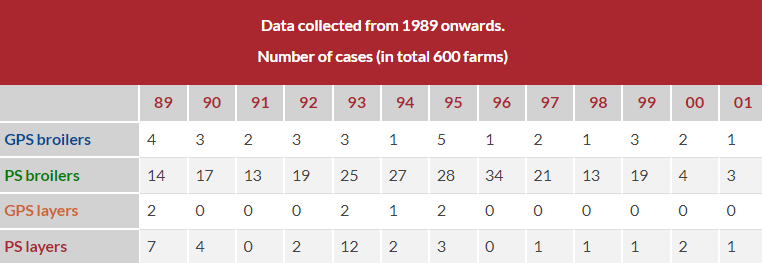Salmonella control – The Netherlands
The Action Plan salmonella and Action Plan Plus introduced in the Netherlands have resulted in a drop in the cases of human salmonellosis reported.
In 1997 the three-year “Action Plan Salmonella” was introduced. Targets were set for maximum infection levels in broiler and laying flocks:
- Broiler flocks – maximum infection level of 1% of flocks sent for slaughter by 1999.
- Layer flocks- maximum infection level of 5% of live flocks at the end of laying by 2000.
The plan consists of:
- Compulsory monitoring
All flocks including breeders, broilers and layers are tested regularly either by cultural methods or serology for the presence of Salmonella infection. - Hygiene measures
These measures affect the entire production chain from breeding flocks to commercial flocks and slaughterhouses.
Emphasis is placed on good hygiene and management controls, changing room facilities and rodent control plans. - Measures for Salmonella-positive flocks
These are dependent on:- The breeding stage of the flock.
- The age of the birds.
- The serotype detected.
Salmonella-positive layers at the end of the laying period – emphasis is placed on preventing Salmonella infection in subsequent flocks. Premises cleaned and disinfected according to regulations. Environmental samples must be negative for Salmonella before new flocks are taken in.
Salmonella-positive broilers at pre-slaughter testing – logistic slaughter. Premises cleaned and disinfected according to regulations. Environmental samples must be negative for Salmonella before new flocks are taken in.
There was a limited and inconsistent reduction in Salmonella infection of rearing and laying flocks between 1997 and 2001.

In 2001 “Action Plan Plus” was introduced. In addition to previous control measures:
- If one flock is positive on a farm, then all flocks have to be investigated immediately.
- Heat treatment of eggs from positive flocks.
- If a flock tests positive, subsequent flocks have to be vaccinated.
The costs incurred if a flock tests positive have caused many farmers to turn to vaccination. In 2002 more than 80% of laying flocks were vaccinated as a preventative measure.
In the third quarter of 2002 only one percent of poultry meat tested positive for S. Enteritidis. Human cases fell by 20-25% from 2001 to 2002.
Survey of Salmonella Enteritidis infections in the Netherlands
- Data collected from 1989 onwards.
- Field trials with Nobilis Salenvac started in 1996.
Number of cases
(in total 600 farms)




